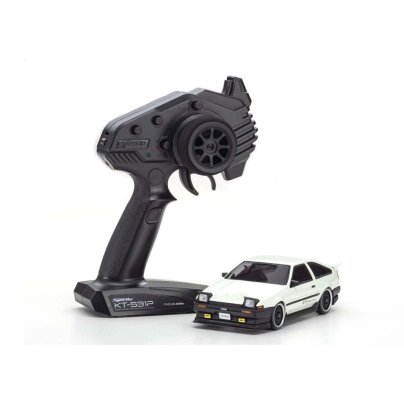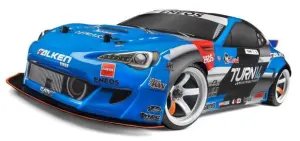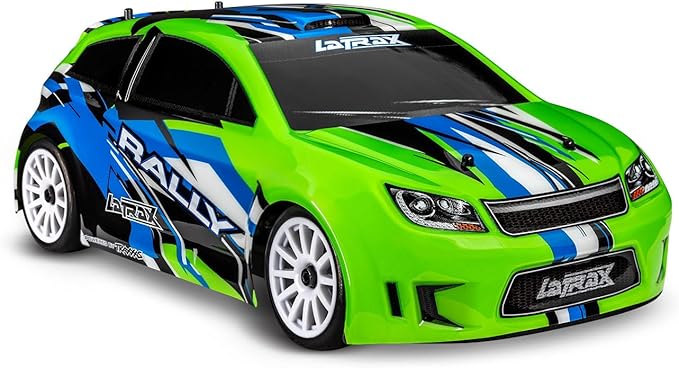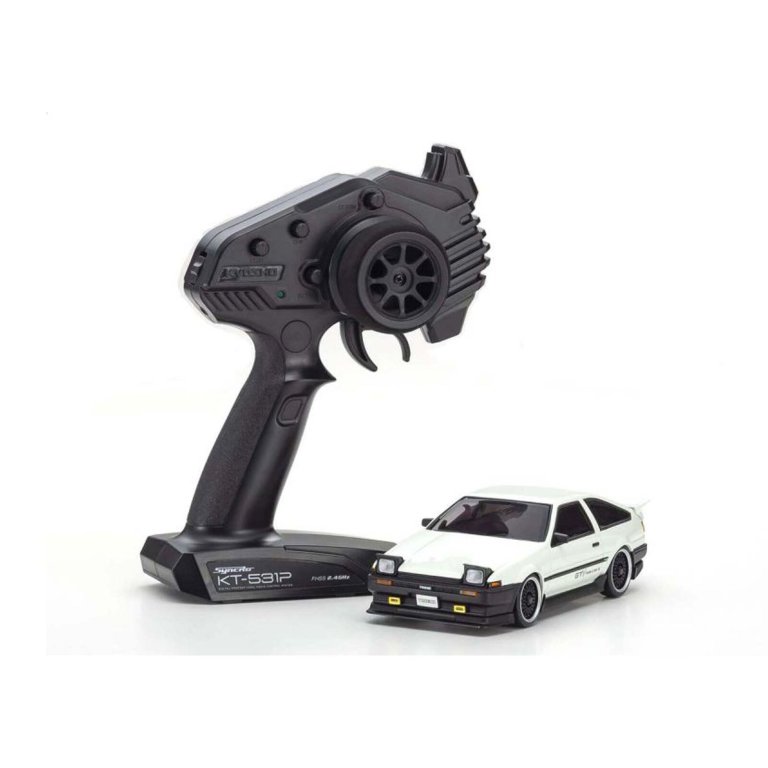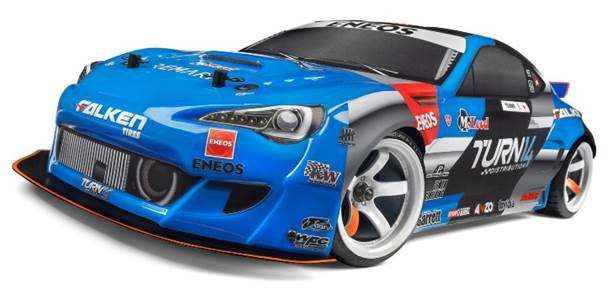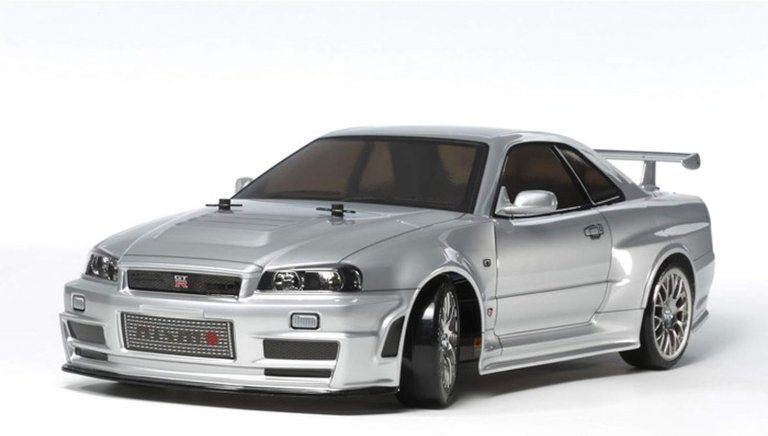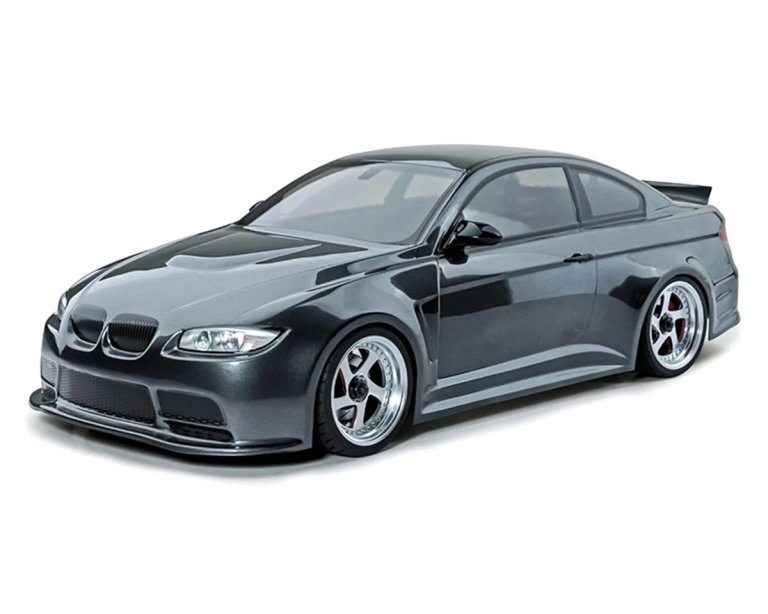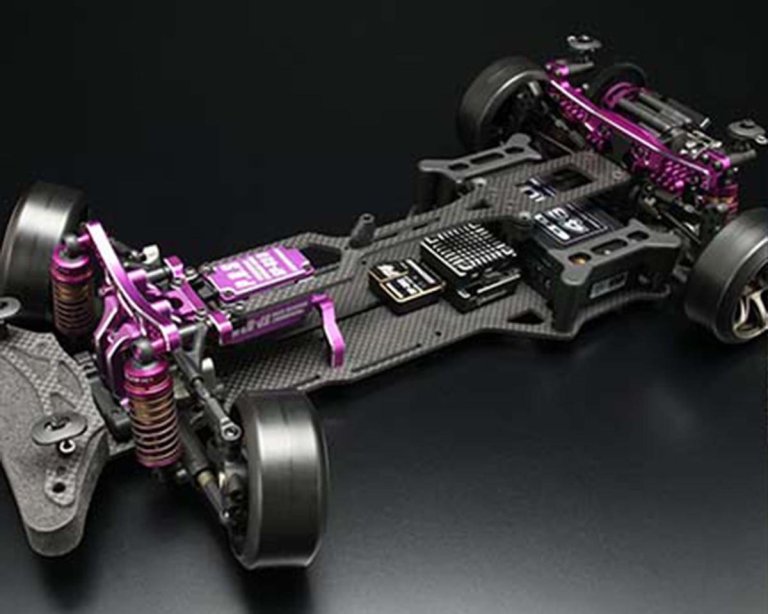We may earn revenue from the products available on this page and participate in affiliate programs. Learn more ›
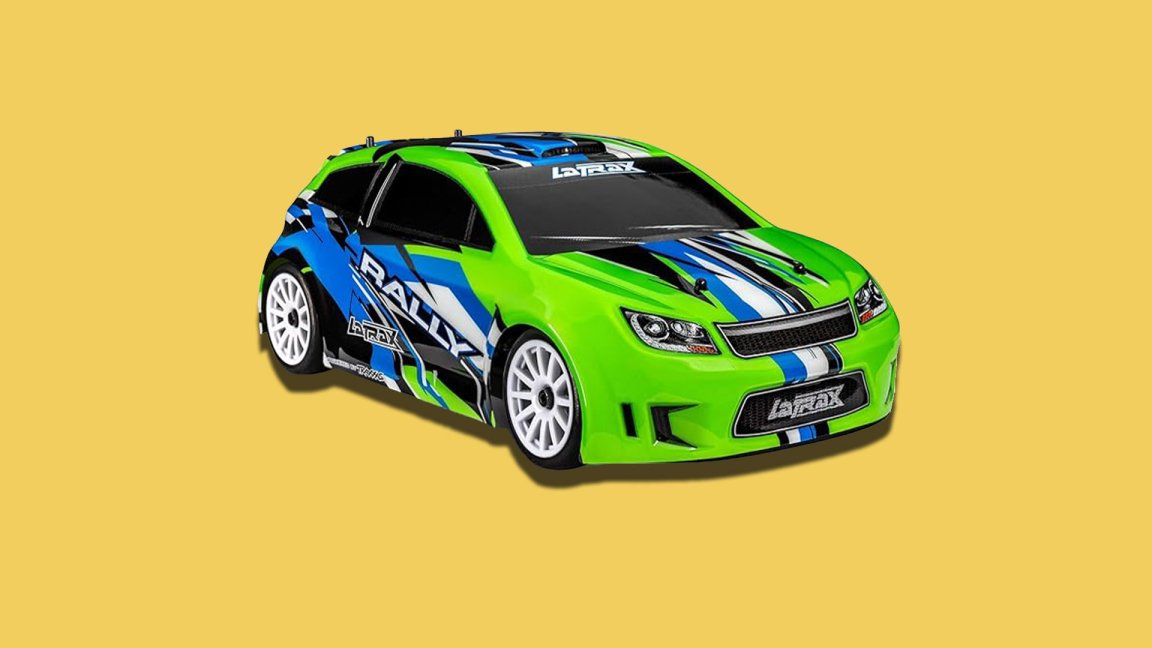
If you want to live out your Ken Block fantasy but your budget will barely cover the cost of a set of tires, you might want to consider an RC drift car instead. Drifting real cars is expensive and takes a lot of work to get right. With RC drift cars you get most of the thrill at a fraction of the price. You just need to know which is best for you to get started with or to ad to your collection.
There are a ton of great RC Drift cars on the market. My favorite is the Traxxas LaTrax Rally 1/18th Scale AWD. It’s not the only great option, though. As with all of our toy car reviews, I’ve rounded up a selection for you to work with. I’ve also laid out a handy buying guide to help you understand how I picked my list of the best RC drifts cars for you to consider.
Summary List
- Best Overall: Traxxas LaTrax Rally 1/18th Scale AWD
- Best Value: Kyosho Mini-Z 1/28 Scale AWD
- Best Realistic: HPI RS4 Sport 3 Drift Dai Yoshihara Subaru BRZ
- Nostalgia Choice: Tamiya NISMO R34 GT-R Drift Special
- Best Intermediate Level: MST FXX 2.0 S BMW M3 2WD Drift Car Kit
- Best Pro-Level: Yokomo YD-2RX Limited Edition
Our Methodology
Countless numbers of car enthusiasts started with RC cars. I blame my own car addiction on my youth spent building and racing scale cars. That knowledge and experience has been combined with firsthand online reviews to compile the list of best RC drift cars you see below. Check out my Laegendary Thunder RC truck review and Laegendary Grando RC rock crawler review for examples of my in-depth knowledge on the subject.
While RC trucks might seem to be worlds apart from RC drift cars, there’s a lot of common ground and I know just what to look for when adding something to this list. Naturally, value and the fun factor are major considerations. I also looked at details such as ease of repair, ability to modify, performance level, and, most importantly, what owners have to say about them.
Best RC Drift Cars: Reviews & Recommendations
Best Overall: Traxxas LaTrax Rally 1/18th Scale AWD
Pros
- All-in-one and ready to run
- High performance and good value
- Fully upgradeable
Cons
- Rally-car looks not for off-road
- Needs a better battery charger
- Limited choice of aftermarket bodies
Specs
- Controller Included: Yes
- Scale: 1:18
- Pre-Assembled: Yes
Rally drivers were drift masters before anyone knew what drifting was. The 1/18-scale LaTrax Rally is the perfect entry into the world of radio-controlled cars. For the price of a few tanks of gas you get everything you need in one box, ready to run. Don’t let the low price taint your perception of the pint-sized slide machine. It features all-wheel drive, four-wheel independent SLA suspension, gear differentials, and waterproof electronics.
The LaTrax Rally will drift right out of the box, but like other hobby-quality cars, there are loads of upgrades available. Everything from full carbon-fiber chassis upgrades down to ball-bearing sets and billet-aluminum suspension arms. Performance parts are available straight from Traxxas or a number of aftermarket tuners. Most of the parts are pretty affordable and installation is easy, educational and fun with basic hand tools.
This is an ideal gift to get kids into RC, but it is definitely fast enough to be enjoyable for adults. You get a pre-built car with a pre-painted Lexan body, a 2.4-GHz controller, 6-volt rechargeable battery and charger. It even includes four double-A batteries for the controller.
Best Value: Kyosho Mini-Z 1/28 Scale AWD
Pros
- Dozens of body choices
- Rugged design and high quality parts
- More educational than an XBox
Cons
- Electronics are Mini-Z specific
- Maintenance tough for young mechanics
Specs
- Controller Included: Yes
- Scale: 1:28
- Pre-Assembled: Yes
There was a time when 1/12-scale cars were considered tiny. Now, Kyosho Mini-Z cars in 1/28 scale are hobby-grade racers small enough to turn your kitchen into a drift circuit. Mini-Z cars are about six or seven inches long and come in a variety of styles from buggies and rock crawlers to exotics and race cars. There are even a number of Japanese classics available, including a white and black Toyota AE86. The cars are available in rear- and all-wheel drive. Surprisingly, the AWD platform is the choice for drifting.
Even at this small scale, they offer four-wheel independent suspension, front and rear gear differentials, and shaft-driven all-wheel drive. All the components of the car are repairable or replaceable, but as you might imagine, all the components including the electronics are specific to Mini-Z. If you search online, you will find plenty of enthusiasts who have trained corners in their basements of dens into fully built drift circuits with pit lanes and curbing, similar to how you would build a slot-car track or model-train layout. Given the choice between a driftable scale model of Tsukuba or a ping-pong table, I know which way I’m leaning.
Best Realistic: HPI RS4 Sport 3 Drift Dai Yoshihara Subaru BRZ
Pros
- Unique motor mount allows for big shifts in weight
- Mostly carbon fiber and aluminum chassis
- As adjustable as a real race car
Cons
- Pro performance at pro pricing
Specs
- Controller Included: Yes
- Scale: 1:10
- Pre-Assembled: Yes
Dai Yoshihara is a legend in Formula Drift circles, so it’s no wonder that HPI chose his Subaru BRZ as a model for its RS4 Sport 3 drift car. It comes as a pre-assembled car with everything you need right out of the box. While it is suitable for beginners, the all-wheel-drive 1/10-scale drifter will also satisfy intermediate-level enthusiasts.
The BRZ body has a nice level of detail, but to really sell it the wheels are miniature versions of the RMK R5s on Dai’s actual car. The tires are realistic copies of Falken RT615s, a favorite of drifters everywhere. Even with all that realism, you still won’t get the smoke rolling off the tires like real Formula D cars.
As with most of the cars on this list, the RS4 Sport 3 uses a plastic-tub chassis with a mid-motor placement and shaft-driven all-wheel drive. Out of the box, there isn’t much suspension adjustability other than ride height by way of the threaded body oil-filled coilovers.
Like all HPI products, a variety of tuning parts are available straight from the manufacturer or from countless aftermarket suppliers. Dai announced his retirement from Formula D at the end of 2021, so who knows. This might even end up as a collectible.
Nostalgia Choice: Tamiya NISMO R34 GT-R Drift Special
Pros
- Realistic looks and performance
- Superb appearances
Cons
- Complex assembly and maintenance
Specs
- Controller Included: No
- Scale: 1:10
- Pre-Assembled: No
For those of us who grew up in the 1980s, the golden age of RC, no other brand holds a candle to the radness of Tamiya. The Japanese plastic-model company took the hobby practiced mostly by middle-aged nerds and added excitement and approachability, making it a pastime for nerds of all ages. This Tamiya NISMO R34 hits all the right notes for those trying to rekindle their childhood love of RC.
The shaft-driven all-wheel-drive system will evoke memories of the legendary Hot Shot buggy. Four-wheel double-wishbone suspension is controlled by height adjustable oil-filled coilovers and the car’s ABS plastic-tub chassis keeps everything mounted as low as possible.
This is a kit and requires assembly, but for some, building the car is half the fun. While this is a well-equipped kit in terms of performance parts — it includes a full ball-bearing kit and aluminum motor heatsink to name a few—it does require you to supply a controller, electronic speed controller, battery and charger.
Tamiya lists this as an entry-level kit, but it requires some familiarity with tools and cars in general. Once built, the GT-R will reward you with precise handling and plenty of straight-line speed. Tamiya is known for going the extra mile in realism, and this kit is no different. The Lexan body is nicely detailed and even includes LED headlights and taillights.
Best Intermediate Level: MST FXX 2.0 S BMW M3 2WD Drift Car Kit
Pros
- Excellent drifting performance
- Highly realistic appearance
Cons
- Shell only, no motor, battery, charger, or remote
Specs
- Controller Included: No
- Scale: 1:10
- Pre-Assembled: No
Most of the other cars in our buyer’s guide aren’t specifically built for drifting, but because of small things like tires, suspension, and differential settings, they function pretty well for casual drifting. When you’re ready to do more serious RC drifting, a car like the MST FXX 2.0 S is a purpose-built car kit that will get you there.
The single heaviest component in an RC car is the electric motor, and cars carry them in a mid-body configuration. The industry favors a rear-mid position. The MST FXX 2.0 S was designed from the ground up to deliver realistic drift physics. The motor is positioned between the front tires, like the engine in real drift cars. To keep things realistic, the car is rear-wheel drive.
What really separates a dedicated drift car from a drifty touring car is the steering angle. Even working around the front-motor design, the FXX 2.0 S is capable of nearly 90 degrees of steering lock for big drift angles. Since this is more of an intermediate vehicle, the suspension is far more adjustable. The front has an adjustable caster, camber, and Ackermann. At the rear, not only are camber and toe adjustable, but the mounting points of the links are adjustable, so you can dial in camber and toe gain as well.
The FXX 2.0 S is sold as a kit, which means the car requires assembly. You will also need to provide a motor, battery and charger, radio, and full electronics.
Best Pro-Level: Yokomo YD-2RX Limited Edition
Pros
- Superior drifting performance
- Highly tuneable
Cons
- Chassis only, no motor, shell, battery, charger, or remote
Specs
- Controller Included: No
- Scale: 1:10
- Pre-Assembled: No
In the full-scale world, there are a few things that separate real race cars from road cars playing race cars in drag. First is the absence of superfluous equipment. Everything that isn’t absolutely necessary for the job at hand is gone. Second is adjustability. The ability to dial in a car for the track and the driver’s style. Finally, there’s cost. Race cars are eye-wateringly expensive, and this Yokomo is no different.
The YD-2RX is purpose built for advanced-level operation and competition driving. Most of the plastic pieces found on other kits are gone, replaced with carbon fiber and billet aluminum. Everything is adjustable. Suspension geometry, kinematics, and even the placement of the electronics are meant to be adjustable to change the center of gravity and polar moment of inertia. The motor mount has seven positions that allow fore/aft balance shift and also allows it to be mounted higher up, above the spur gear. Moving the mass up allows skilled drivers to flick the rear end of the car in direction changes.
When you buy a car at this level—and calling it a car is generous—you are getting a chassis. Not only do you need to supply the electronics, you will also need tires and wheels, plus a body of your choice. The YD-2RX is the fastest RC drift car on our list and will obviously outperform anything else here, assuming you have the driving skills to use it and the mechanical skills to set it up.
What to Consider When Buying RC Drift Cars
There are a couple of key things to consider when shopping for your RC drift car. First, consider how you’re going to use it. Do you want to drive it indoors or out? Is there a local track that only allows one scale of car? Next, what is your skill level? Be honest. We all think we’re Dai until we hit the pavement and find out we’re duds. Pick a car that’s at your skill level as a driver and in technical terms.
Types
Kits
Up until a few years ago, all hobby-grade RC cars were sold as kits you were required to build yourself. Unassembled kits are becoming rarer by the day. From an educational standpoint, the kit is far better as you literally see how the automotive sausage is made. From a practical standpoint, when your car breaks, you already have a pretty good idea of what you need to do to replace parts. If you’re buying an RC car for a car enthusiast, we suggest trying to find a kit.
Ready To Run
Browsing hobby shops, either brick and mortar or online, the vast majority of RC cars you find will be fully built and ready to run. When you see “ready to run” or RTR on the box, that generally means everything you need is in the box. At most, you will need to supply the batteries for the radio. Buying everything together is almost always a better value.
Ready to run doesn’t necessarily mean it’s beginner level. A variety of intermediate kits will come RTR as well. While you will likely get a better deal buying everything together, pay attention to the quality of components included. Try to find a package that includes a radio that can be used with other cars so you won’t have to buy everything a second time when you’re ready to upgrade.
Key Features
Chassis
The chassis is the main structure of your RC car — or any car, for that matter. The majority of RC cars use a bathtub-style chassis with a box section running front to back holding either a driveshaft or drive belt. The sides of the tub are used as stiffeners as well as protecting everything inside. A tub chassis is strong and relatively light, and it can also use access panels on top to be water and dust resistant.
The fastest RC drift cars will use a pan-type chassis, normally made of aluminum or a composite like carbon fiber. The rigidity of the material allows for a flat plate without the sides as in a tub chassis. If extra stiffness is needed, a second plate is mounted anywhere from a half inch to an inch above the main plate and attached along the length of the car.
Motor Type
There are two main types of electric motors used in RC cars. The first is what’s known as a brushed motor. This is ancient tech dating back to the time of cave paintings and disco music. A brushed motor uses a mechanical rotary switch called a commutator to change the polarity of wound copper coils on the internal rotor, called the armature. The armature sits inside permanent magnets and as the directionality of the armature changes, it spins.
The new hotness in RC car motors is brushless technology. These transfer the heavy windings to the outside of the motor and the magnets are located on the rotor. Instead of using a mechanical switch, the polarity is controlled by a microchip.
Brushless motors are more efficient at converting electricity into motion. On top of that, the brushes in brushed motors are consumables, meaning they require replacing on a regular basis. The advantage of brushed motors is cost. Brushless motors and controllers continue to fall in price, and eventually, the longer life span, higher performance, and economies of scale will make brushless obsolete.
Drivetrain
Real drift cars are rear-wheel drive. The most realistic RC drift cars are also rear-wheel drive, but all-wheel drive is common in beginner- and intermediate-level cars. The technique of drifting an all-wheel-drive car is different from a rear-wheel-drive car, but the thrill of tossing the back end around, rotating it around so the cars perpendicular to its direction of travel at the apex and then kissing the curb rear wheel first at the exit, is most certainly not.
The most common form of all-wheel drive is shaft drive. Just like real cars, a solid drive shaft runs the length of the car connecting both front and rear differentials. Some cars will use a third, center differential to dole out power front and rear depending on which end has more grip, but these are less common in drifting than “grip” driving. The second form of all-wheel drive uses a belt instead of a shaft. These may be slightly lighter than driveshafts, but belts stretch and require tensioning or replacement when worn.
Rear-wheel-drive cars will normally use a gearbox to transfer power from the rear or mid-rear mounted motor to the rear differential. Rear-wheel drive obviously offers more realistic driving dynamics for drift cars and is more efficient in terms of power loss as well as being lighter.
Radio
Radio, controller, and transmitter are the most common names for the device you use to remotely control your RC car. If you’ve been in the hobby for a while, you might remember the days of hanging colored flags on your radio’s antenna and having to change frequencies when driving with friends who were on the same frequency. Modern 2.4-GHZ radios bind to the receiver in your car. Once synchronized, they switch channels many times a second, meaning your radio won’t interfere with others around you.
Most cars now require two channels, one for throttle and one for steering, although multichannel car radios are pretty common now. The pistol-grip style of controller with a trigger for throttle and brake and a side-mounted wheel for steering is by far the most common. Twin-stick systems can still be found if you make an effort.
Beginner RC cars will quite often include a radio, but you might want to upgrade as you get more experience. A high-quality radio is an investment as you can use it on multiple cars in your collection. Find one you like, and it may last years of driving.
Battery
Anyone paying attention to the EV market knows that battery technology is everything when it comes to range and performance. There are two types of common batteries in the RC car world: NiMH (nickel-metal hydride) and LiPo (lithium polymer). The chemical differences between the two are beyond the scope of this article, but we can look at the basics of functionality.
Both types of battery packs will have two important ratings; volts and milliamp hours. The pack’s voltage will determine how much power your car can make, while milliamp hours is how long the car will run. Think of it as how much gas you have in the tank.
NiMH is the older of the two technologies. Normally, these battery packs are made of individual 1.2-volt cells connected in series. You can find these in anything from 6.0 up to 9.6 volts. Since they are in series, the mAh (milliamp hour) rating of the pack is the same as an individual cell. NiMH is very stable, is less expensive, can be completely discharged without damaging the battery, and can be stored at any state of charge.
LiPo is the newer and arguably better tech. These packs are usually made of 3.7-volt batteries in series. LiPo has greater energy density, meaning a comparable pack will be smaller and lighter than NiMH. They also deliver more consistent voltage, so your car will be faster for longer. The downside is LiPo packs can be damaged by overcharging or over-discharging. Running LiPos requires speed controllers and chargers with built-in voltage detection. The cost of LiPos and electronics is at minimum 50 percent more than NiMh, but for some it’s worth the price.
Body Material
Just about any hobby-grade RC car will include a Lexan or polycarbonate body. This is thin vacuum-formed plastic, the same as many eyeglass lenses, that is surprisingly rugged. While many cars now include a pre-painted and pre-trimmed body, most kits will include an unpainted and untrimmed body.
Lexan is clear, so RC car bodies are painted on the inside, using paint made specifically to stick to and flex with the Lexan bodies. Trimming the body can be a challenge for beginners. Scoring and snapping is a preferred technique for clean lines. If the body is made specifically for the car you’re installing it on, guide lines will usually be molded into the body.
There are a few exceptions in body material. Tamiya has released a few collector models in recent years that include injection-molded ABS plastic bodies. Injection molding allows for far more detail than Lexan with tighter radii on edges and details like screw heads to be molded into the body.
Speed Control
Electronic speed controls are like your real car’s throttle body. It translates the signal received from the car’s controller and determines the voltage delivered to the motor. Originally, RC cars used an array of size resistors to “throttle” the motor. Today’s speed controllers use FETs (field effect transistors) to control the motor.
Most of today’s speed controls can be used with either NiMH or LiPo battery packs, although you may need a separate connector for voltage sensing on LiPo batteries. Speed controllers will not transfer between brushed and brushless motors. Several RC car manufacturers now sell both versions of their vehicles from the factory, the brushless version obviously being the more expensive and higher performance of the two. If you think you will want to go brushless later on, it might be worth the extra expense of the upgrade up front.
Our Verdict
Our pick for the best RC drift car is the Traxxas LaTrax Rally. The 1/18 scale is not only the best value on the list, its small size makes it usable indoors while it’s rugged enough to handle streets and parking lots. The all-wheel drive drifter is fast out of the box but can easily be made faster.
We’d love to hear what our readers have to say about your own experiences with RC drift cars. Do you drift now? Are you an RC racer looking to get into drifting? Have you used your RC drift car to film your own mini gymkhana? If so, get in the conversation below.
FAQs
You’ve got questions. The Drive has answers.
A: Absolutely! Kind of. OK, in the real world, drifting is overpowering the rear wheels and maintaining a drift by pointing the front tires in the direction of travel. That makes it sound easy. Technically, you need an RWD RC drift car to do the same, but you will find RC drivers drifting AWD or 4WD cars everywhere.
A: The most common scale for RC drift cars is 1/10. However, you can find them in everything from 1/28, which are about six inches long, up to massive 1/6 scale cars, which are 25 inches long.
A: Beginner cars can hit 20 or so mph, which seems fast. The fastest RC drift cars are capable of speeds up to 70 mph, although it’s pretty uncommon for anyone to drift at that kind of speed.
A: The easiest way to make your RC drift car faster is to use a higher voltage battery pack. Beyond that, if you are still using a brushed motor, upgrading to brushless will definitely make it faster. Much less effective is to remove weight. RC cars are already light, so shaving off weight is going to return minimal results, unlike with real cars.

